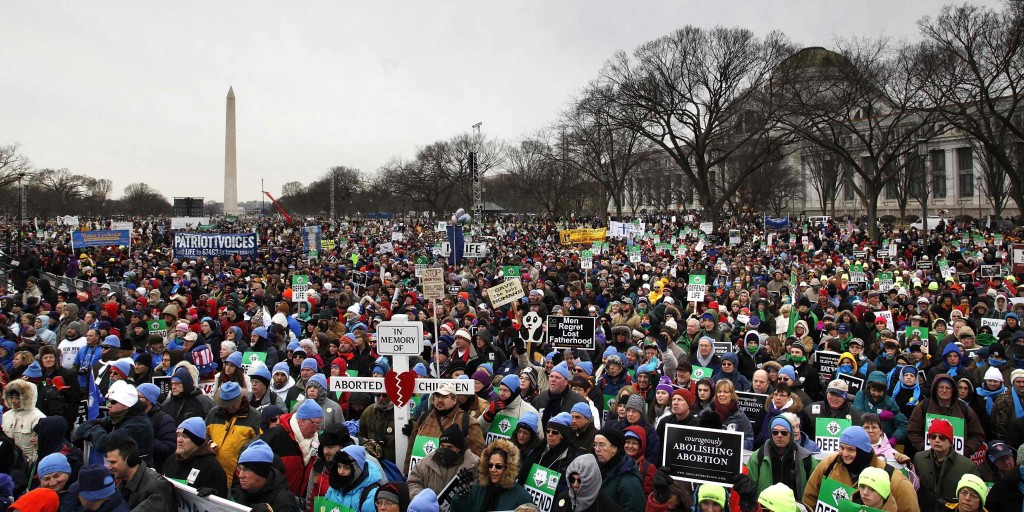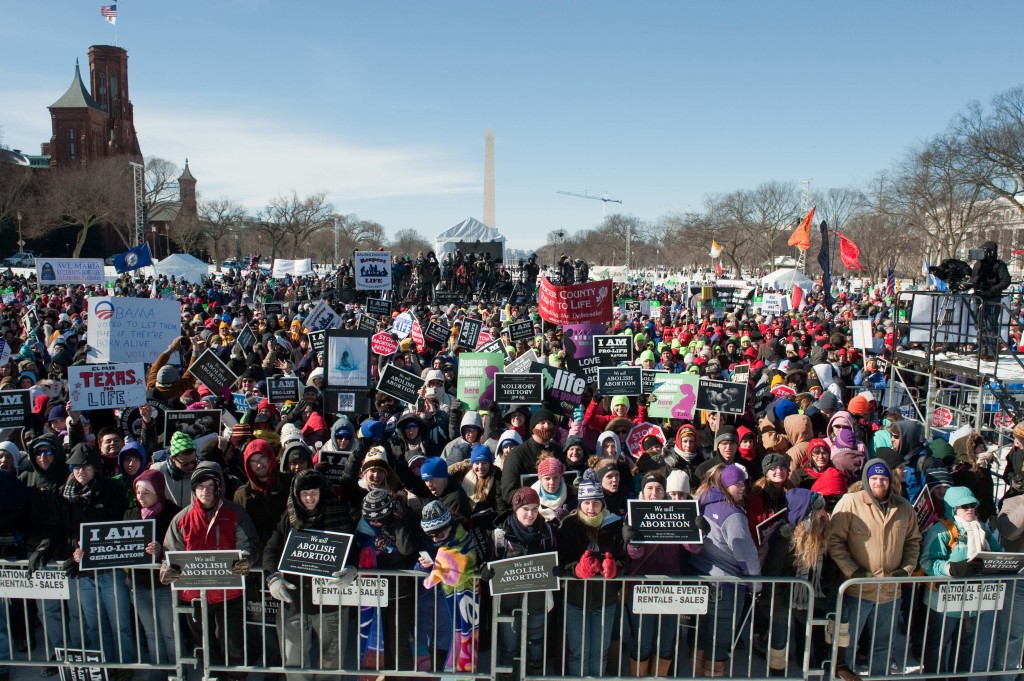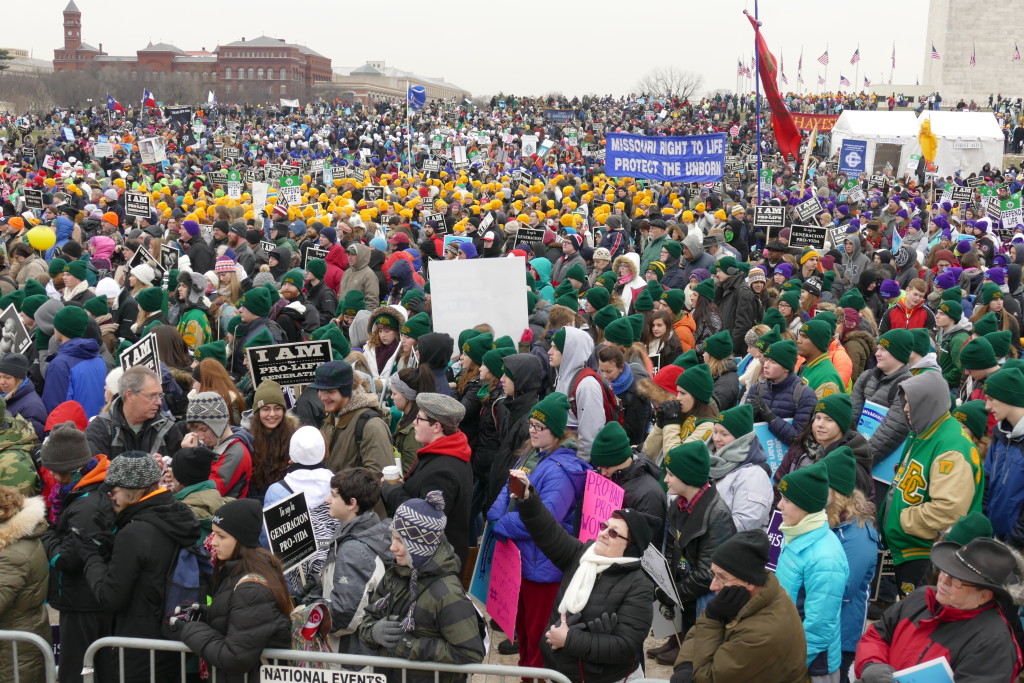People’ve been arguing a lot about crowd size lately, and these arguments have now spilled over into debates about the size of the annual March for Life compared to the (truly enormous) size of the Women’s March on Washington. March for Life organizers and friendly press routinely claim the March for Life draws crowds well into the hundreds of thousands. Yesterday, President Trump himself argued, as many conservatives have, that the media ignores large crowds at the March for Life while heavily promoting large crowds at pro-abortion rights rallies like the Women’s March.
There is no doubt considerable truth to that. The March for Life is an annual comedy of news bias in which reporters routinely pay as much or more attention to a few dozen pro-choice counter-protesters than to the thousands and thousands of pro-lifers on the Mall… and that’s assuming they notice the March at all. Media crowd size estimates at the March for Life are routinely ridiculous lowballs (“hundreds”? seriously?). This despite the fact that the March for Life, even given conservative assumptions, is routinely the largest march on Washington of the year… and it happens every single year.
However, the crowd at the March for Life is almost certainly much smaller than the enormous (400,000+) estimates routinely given by its supporters. Let’s take a look.
Here’s a lovely image of the 2013 March (in their pre-March rally), courtesy of Iowans For Life:

This is a huge crowd, no question. That’s the Natural History Museum in back, and this rally appears to be as long as its entire facade — one full block of the National Mall, packed in with protesters.
One full block of the National Mall, as we’ve seen during the recent roaring debates about inaugural crowd sizes, works out to 50,000-ish people, emphasis on the “ish.”
Images from other years and other locations seem to generally support the “roughly one block of the National Mall” estimate.



Based on this evidence, it seems reasonable to estimate that the March for Life crowd size is between roughly 30,000 and 100,000 each year.
The March for Life itself must file a permit application each year, and this permit must list the organizers’ anticipated attendance. This year, as in past years, the March for Life officially estimated an attendance of 50,000 — broadly in line with my own estimates. (SOURCE: D.C. Protest Permit Applications, January 2017)
Moreover, the last time the National Parks Service estimated the size of a March for Life, in 1995, their estimate placed the March at about 45,000 attendees. (Congress withdrew NPS’s authority to make official protest estimates later that year, after an unrelated brouhaha in which NPS reported that Louis Farrakhan’s “Million Man March” did not, in fact, have a million men in it.) That estimate is now twenty years old, but, once again, it broadly lines up with our estimate of 50,000-ish, emphasis on the “ish”.
Some former marchers have privately suggested to me that this estimate is off-the-mark by a wide margin. One marcher, from the 2013/14 event, recalled on Reddit that, even though he was in the back half of the march both years, “from the hill of the Capitol, looking back, I saw a sea of people. Every block visible was completely full.” (I initially misunderstood his statement, which is reflected in my reply to him, but I have since familiarized myself with the route of the March in 2013/2014.)
In those years, the March ran from the Natural History Museum at 9th Street down Constitution Ave. to the Supreme Court building. There’s no way this Redditor was able to see that entire expanse, but let us suppose, for the sake of a generous estimate, that, at the peak of the March, the Marchers filled the entirety of Constitution Ave. from the March’s start at 9th Street, all the way down to First Street in front of the Supreme Court building.
Google Maps tells me that that distance is 1.1 miles, or 5808 feet (roughly). Constitution Ave.’s width varies, but the average over the route is about 8 lanes of traffic. Assuming 12-foot lanes, Constitution Ave. is 96 feet wide on average. That’s 557,568 ft2, or 51,800 m2.
We know that you can fit about 5 persons per square meter if they’re standing still. Any more and you risk their safety. Once they start moving, the dynamics become more complicated, and you end up with a limit of about 3 persons per square meter.
So, assuming the March for Life completely saturated its entire marching space, multiply the total area in meters by three persons per meter, and we end up with an estimated attendance of 155,400 in 2013 and 2014.
However, because of the generous assumptions granted in this estimate, this figure must be taken as an upper limit. Video evidence of these and other marches suggests that the March for Life fell well short of complete simultaneous saturation of all available streets. This points us back toward an estimate in the 50,000 – 100,000 range.
(For comparison, the Women’s March, generally estimated at about 500,000 strong, came close to saturating not just a lengthy stretch of Constitution Ave., but also a large portion of the Mall and a number of other side streets, as you can see in this photo taken by Lucas Jackson of Reuters and originally hosted by The Atlantic.)
I say none of this to pooh-pooh the March for Life. There is much that is immensely impressive about the March. Very few causes are able to bring out 50,000+ people to march on Washington. Even fewer have done so in the face of an apparently deliberate media blackout effort. No other cause has been able to pull such an impressive spectacle together, against all odds, every single year. This year marks forty-four consecutive years of the March for Life, through all kinds of weather despite all kinds of political situations.
The March for Life is a totally non-violent protest against the greatest ongoing act of violence in the history of the world. The moral arc of the universe is long, but the March for Life will be remembered as its vanguard. 2017’s gathering, featuring the Vice President of the United States for the first time in the March’s history, promises to be an especially successful event, and I suspect the media will be forced to finally pay attention to the fact that, outside the media bubble, the majority of Americans want to enact major restrictions on abortion.
However, I am concerned that pro-life advocates are placing the March for Life on a pedestal from which it will inevitably be toppled. I would hate to see us get into a fight about crowd sizes that will only give the media a cheap reason to dismiss the objective enormity of our movement. So bear these two things in mind as we go into the March for Life tomorrow:
The 2017 Women’s March on Washington represented a paroxysm of one-off, anti-Trump frustration, which is unlikely to crystallize into the sort of sustained, successful resistance movement that the pro-life coalition has built. Nevertheless, it is almost certainly the case that the 2017 Women’s March on Washington was at least twice as large as any recent March for Life.
There is little reason to suspect that the March for Life will have even 200,000 attendees in Washington this year. Crowd estimates by organizers and supporters that are higher — often much higher — should be disregarded as wishful thinking… unless backed by solid evidence.
I am, as always, open to considering any and all other evidence about the size of the March for Life. Comments are open below.

Comments open.
When I went to the March for Life a few years ago (2011 maybe?), I attended the youth rally mass in the Superdome. Now the Superdome seats 75,000+ people and it was completed filled, plus all of the clergy that were seated on the field itself. On top of that, I know that there were overflow masses in every Catholic Church and other places beside across D.C. (we heard this from the Georgetown Visitation high schoolers group, who knew people attending those masses). And that’s pretty much just the Catholics. So I would say that 400,000 is a pretty crazy estimate, but 50,000 does seem pretty low to me. My guess would be closer to the top of your range – 150,000 – at least in the year I attended.
But I also think you are right that this is mostly semantics. The fact is, the Women’s March was a huge (and pretty cool to see, honestly) thing that happened. But the March for Life has been consistent for nearly half of century in the face of total media suppression. So that’s pretty cool, too.
When you say the Superdome, is that RFK Stadium? Asking so I can look into this better. Thanks for offering another angle with potential crowd-size evidence! –James H
I don’t know if their using the “Superdome” for Mass, and I am also pretty sure that no sporting stadium/arena in the D.C. area is called the “Superdome” (that’s in New Orleans, right?). However, they do annually use the Verizon Center, in Chinatown, for Mass. Each year, it hits a capacity of 20,000+ people.
I think perhaps the large numbers include all the March for Life rallies around the country around this time, and not just the one in DC.
This… this makes a heck of a lot of sense. And then those numbers get picked up by other outlets and mixed up.
Yes, I can buy this. I’ll think about it some more, maybe run some numbers if there’s time. Thank you for the suggestion! –James H.
Couldn’t you take the video of the march, get some graphic editing software to count heads, run the tape, and get a pretty accurate count? FB tries to do facial recognition, this would be far simpler. The software must already exist.
Such software exists, but it’s both expensive and I don’t think the algorithms it uses will do well with large crowds; it’s more designed for businesses to track foot traffic.
Of course, if anyone has access to such software, I’d be delighted to see what it comes up with for a count! –James H.
I’ve been to around 6 or 7 marches for life in DC and this one was by far the largest. I had my children with me so we got started with the walking part early before the rally was over, and when I looked back from the capitol towards the Washington monument I could see that there were still many people who were milling about getting ready to walk. By the way, before I joined the walking part there had been a very sizable I’d say 5 blocks length of people who were marching already… Hard to estimate the numbers, but I have been to stadiums with 80,000 people and this was way way bigger. I would say it is impossible that there were less than 100k people there.
I buy this. The video I’ve seen looked… very impressive. I just haven’t been able to pin it down to a figure! –James H
I ended up in the middle of the march for life in 2014 by accident. It filled about a block solid, and beyond there a bit on the side streets. I’d say 50k is a good estimate.
Meanwhile, the women’s march was on a whole different level. You couldn’t move anywhere on the mall and beyond for two blocks. I’d say your figures are dead on.
While it has been a few years, I did attend a handful of Marches, in back-to-back years, within the past decade.
I may be wrong, but I am fairly confident that the March took up more than one block on the National Mall. The first one that I ever attended was in 2009, just a few days of Obama’s inauguration. I went out of my way to ask a crowd control police officer what her estimate was, and she said that she wouldn’t be surprised if there were as many as half-a-million people there that year.
I don’t claim that her estimate is either official or accurate, but I suspect that she would have some experience in that field, given her line of work, and that she’d also have a fairly unbiased perspective.
Police do tend to know what they’re talking about! And, to be fair, I have no crowd photos from 2009, so who knows?
Still… half a million is a HUGE crowd. That’s, like, five blocks of the Mall plus solid packing in on Capitol Hill *plus* big-time overflow into side streets.